| 40. History and Evolution of the Finn Mast |
by Gus Miller and Andy Zawieja |
|
The Finn is famous for having an extremely powerful rig. At first it was overpowering - so overpowering that many thought it was impossible to sail a Finn in more than 12 knots of wind. The original masts were stiff, like solid telephone poles, although the original design competition specifications called for a hollow mast with a luff groove.
Original masts
Jack Knights said that the original masts looked as if they had been felled in a forest. They just rotated and did not bend. There was a hole for the boom. Sailing a boat with such a mast was very difficult. No one ever claimed to have mastered the boat in heavy winds.
Developments
Over the years, sailors (especially Paul Elvstrom) found that smaller diameter, bendier masts allowed them to adjust and change the sail's shape and extend the rig's wind range. This requirement to change a full sail into a flat sail really changed the mast's profile. One problem discovered was that when the sail flattened, the draft moved backwards. This resulted in the incorporation of a second tack grommet in the late 1950s to pull the draft back forward. This second tack grommet came to be called the Cunningham.
|
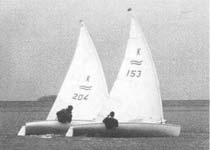 |
Evolvement
The mast has continued to evolve so that at the 1992 Gold Cup in Cadiz, Spain, a fleet of 94 Finns were racing in 40+ knot winds without many problems. The mast handled such wind by bending so the sail flattened, twisted and depowered automatically. The same mast and sail combination also has to be very effective in light winds. One of the attractions of the Finn is the possibility of adjusting the mast, boom and sail to the particular weight, sailing style and ideas of the sailor.
|
|
In 1952, no one expected that a rotating mast could make such an evolution. Many experienced sailors and sailmakers say that more time, thought and experimentation have gone into developing the Finn rig than any sailboat in history. It is easy to build a sail for an America's Cup boat because the crew will find out where it is good and use it happily in that condition. It is very difficult to build a single sail that will be completely competitive in the range from 1 to 41 knots. |
IFA
The other important element in this evolution has been the International Finn Association's Technical Committee that writes and oversees the measurement rules. The guiding principle and tradition has been that the class be open to progress, modernisation and the development of better performance provided that any change would not outdate the present fleet. Changes must be implementable in the existing fleet of boats. This has meant that 10 to 17 year-old boats have been able to win a World Championship. It has also meant that for four decades the Finn has been the first to develop many concepts and techniques now common in high-performance dinghy sailing.
Wooden mast developments
Over the years there were many wooden mastmakers. In England, Collar masts were very popular. The Soviets used Siberian Spruce. North American sailors used aircraft grade Sitka Spruce.
|
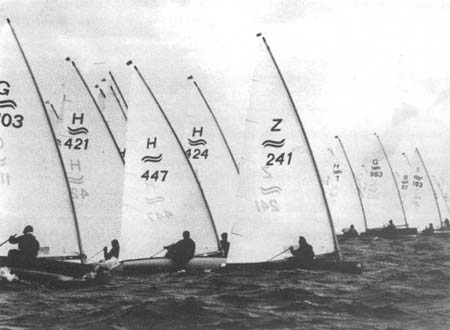 |
|
Elvstrom wooden masts had a period of great popularity. There were many secrets. For instance, what kind of glue should be used, because there were many different glues available. The bend characteristics of wooden masts changed with sunny days and rainy days. It required considerable knowledge to know how to change the mast to match weather conditions. Another problem was breakage at the weak place caused by the boom hole. This was solved by reinforcement with oak or other strong wood.
It was important for masts to bend down low, because the fullness of the sail was mainly in the lower half. Many broke if the sailor made the front too soft. Elvstrom always said they were fastest just before they broke. Masts were softer up high to depower the upper sail first. The Polish fluid dynamist and author of Theory of Sailing, Czeslaw Marchaj, said the sail should change shape evenly and not look like a pear, but without dacron, and having only cotton, which was unstable, this did not work. The ideal sail at the time was flat at the top and full at the bottom. As the masts got smaller in the upper section, the rule requiring a 40 mm top had to be changed at a Gold Cup to get rid of the top knob most masts had to meet the letter of the rule.
|
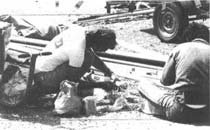
|
Dacron
Dacron sail cloth was approved for use after January 1 1960, and initiated new directions for the mast. By 1963 dacron sails could be set on even more bendy masts. This had given lighter helmsmen the ability to compete well upwind and a dramatic advantage offwind. Austrian Hubert Raudaschl won the Finn Gold Cup in 1964 with a new home-made wooden mast and a dacron sail.
|
|
Bruder masts
By 1968, Brazilian Jorg Bruder and Hubert Raudaschl had designed a mast and dacron sail combination where the mast was much stiffer at the top with an even bend. Bruder had found that one mast at his home club was faster than any other and he measured it carefully to find out why. The base of his new mast met the rule that the mast had to be 100 mm at the deck but the mast became an ellipse sideways just above deck. Masts commonly bent 22 cm in the middle. Bruder's new mast bent only 15 cm. The key change was the small fore and aft elliptical shape of the top meter of the mast. The small tip bent sideways easily and coupled to the upper leach to allow it to twist off automatically. In the next few years, Bruder did not glue the front of the mast in order to make it even softer down low. He eliminated the boom hole on his wooden masts and made a metal gooseneck. He also used Parana Pine, which he claimed was superior.
Halyards
The sailor could adjust the halyard in the beginning. Up to 1966 the halyard came into the cockpit and the sailor could release it when off the wind. Masts had wooden grooves or small 'V blocks to keep the halyard in front of the mast. Sailors found that this halyard arrangement often resulted in too much mast compression. After 1968 the halyard changed to a halyard hook. |
Vangs
The first masts had no vangs. Then some newer masts began to have a wedge that rode over the top of the boom in the mast's boom hole to keep the boom down. That resulted in the same boom position for the full race. Then came arrangements to adjust a wedge under the boom during the race. Next came wheel vangs in the late 1960s. In the early 1970s sailors started using metal levers and multiple blocks. A favourite game was to invent new fittings for masts. The most popular has been the double-lever vang designed and made originally by Art Diefendorf for Vanguard. The outhaul had knots to adjust and come around the end of the boom. There was no inhaul. Russian Valentin Mankin used a wire outhaul. After a while, he feared that the wire would decapitate him on a jibe. He finally had to break it with his paddle.
|
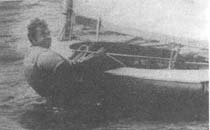 |
Wooden masts made by
Jorg Bruder (below) dominated
the Finn scene in the late sixties |
|
Aluminium masts
Many were dreaming of metal masts in order to eliminate all the variables and problems of wood. They never imagined the metal mast would make so many problems of its own.
|
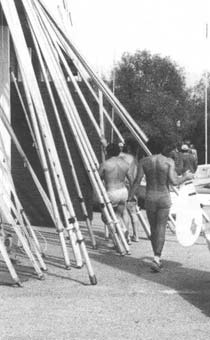 |
In 1967 the Class asked the IYRU for permission to experiment with glass and aluminium spars. In 1968 several spars of aluminium or glass were produced and tested and the IYRU approved the use of these materials for racing. In 1969 Jack Knights brought an aluminium mast to use at the Gold Cup in Bermuda. Competition between builders was really good in the beginning. Boyce, Bruder and Z-Spars all built one-piece aluminium masts with early success. Stromeyer, a Swede in Austria, built a stainless steel mast. Needlespar built a mast with different size tubes glued together over sleeves. By 1972 about one-third of the Finn sailors were using aluminium masts. Bruder won the Gold Cup in 1972 with one. Bruder's winning the Gold Cup using his own aluminium mast convinced many of the top helmsmen that aluminium masts were better.
Many early aluminium masts broke at the deck or the gooseneck and had to have wooden poles or metal tubes inside the lower section to keep them from getting permanent bends at the gooseneck or from breaking.
1972 Olympics
At this time, the host country for the Olympics supplied both the hulls and the rigs for the Olympics. Many were surprised when the IYRU directed the Germans to provide aluminium masts for the Finn class, as many sailors had never used aluminium masts. Needlespar (England) won the order for 100 of their 2B masts for the Kiel Olympics after David Hunt promised that all masts would be perfectly identical. The supplied rigs at previous Olympics had never been really identical. This order helped kill off the other aluminium builders.
|
| Masts, masts and more masts! |
|
Needlespar
The 3B came in 1973 as a development of the 2B with constant wall thickness and a wide elliptical base. The 3M came in 1974 at the Finn Gold Cup with a smaller lower section of variable wall thickness, a three-piece top and took over. In 1975 Needlespar produced a delta-shaped lower section and single-piece top that was very good in light air but too soft at the deck for heavy air. In 1975 Needlespar also produced the 4B that incorporated a two- piece top over a wide elliptical base but it never was as good an all-round mast as the 3M. Since 1974 the 3M has been the most successful aluminium mast with many different tips. Every time Needlespar's designer David Hunt needed a new car, he came with a new tip design for the 3M with a different colour tip. The sailors would buy a new spar, hoping to find a superior coupling of mast top to upper sail leech. At latest count there are black, blue, silver, gold, red, green and purple coloured tips located in Finn fleets around the world. However, the development of the aluminium mast ended up eliminating many light small guys, who were 1/3 of the fleet, because the aluminium masts never developed the tip release of the wooden mast.
|
|